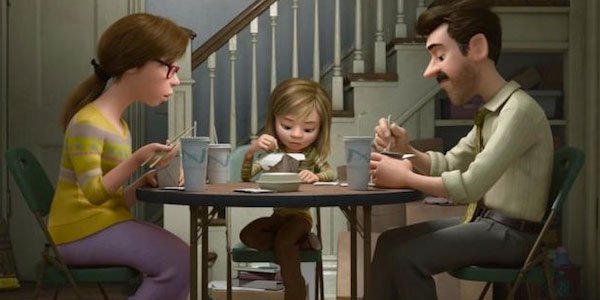Why Inside Out's Main Character Has Male And Female Emotions

When watching the "Family Dinner scene" in director Pete Docter’s Inside Out, you may have noticed something interesting. While the young Riley is shown to have emotions of different genders – with Joy clearly being female and Anger clearly being male – the same cannot be said for the personifications of the emotions in the minds of her parents. There are probably many ways that this can be interpreted – including pragmatic reasons from a marketing and storytelling perspective – but it turns out Pixar Founder John Lasseter has a theory of his own about this interesting difference, and it all has to do with changes we go through as we get older.
Lassetter’s thoughts on the matter were actually shared with my by Pete Docter when I had the chance to sit down with him for a one-on-one interview a couple weeks before Inside Out was released. Discussing the genders of the emotions in both the mind of Riley and her parents, I explained how I interpreted it as people maturing into more gender-specific individuals, and the filmmaker explained that Lassetter had similar thoughts on the matter. Said Docter,
I remember, we talked to John and he said, ‘Well, I thought you did it because, as adults, we become more kind of set in our ways. As a kid, you can... anywhere is possible.’
Explaining his own approach to the dinner scene in Inside Out, however, Pete Docter said that they were ultimately two things that were absolutely vital to the scene: clarity and comedy. Had Riley’s parents both had multi-gendered emotions like their daughter, the scene would have been going back between 18 different characters, and it was a bit unruly unless everyone was identifiable. Not only did making the emotions gender specific in the parents make the sequence easier to follow, but it also opened up an opportunity to create a few extra laughs. Explained the director,
For the comedy of it, we’re cutting between 18 characters and 4 locations in that dinner scene, so we just went broad with it - kind of how SNL would do it. They all have like dopey obvious mustaches or big red glasses so that you’re instantly clear on, ‘Oh, it’s mom; it’s dad.’
When you saw Inside Out, how did you interpret the dinner scene and the differences between Riley’s emotions and her parents? Did you not think twice about it, recognizing it as a necessary story tool, or did you formulate your own special interpretation of what it meant? Hit the comments below with your thoughts – and if you haven’t seen the movie yet, go check it out, and then come back here!
Your Daily Blend of Entertainment News

Eric Eisenberg is the Assistant Managing Editor at CinemaBlend. After graduating Boston University and earning a bachelor’s degree in journalism, he took a part-time job as a staff writer for CinemaBlend, and after six months was offered the opportunity to move to Los Angeles and take on a newly created West Coast Editor position. Over a decade later, he's continuing to advance his interests and expertise. In addition to conducting filmmaker interviews and contributing to the news and feature content of the site, Eric also oversees the Movie Reviews section, writes the the weekend box office report (published Sundays), and is the site's resident Stephen King expert. He has two King-related columns.
